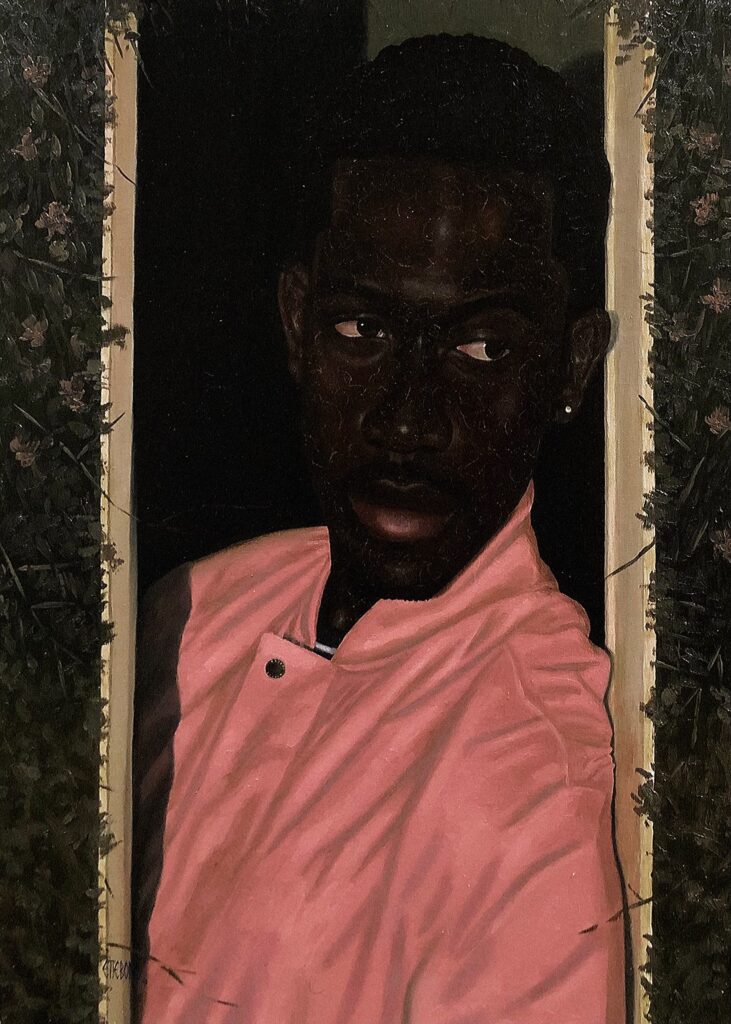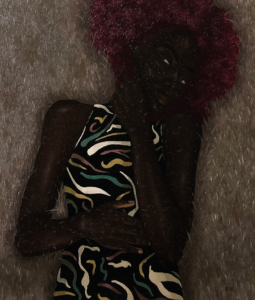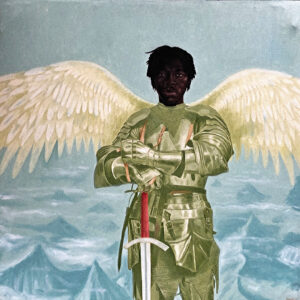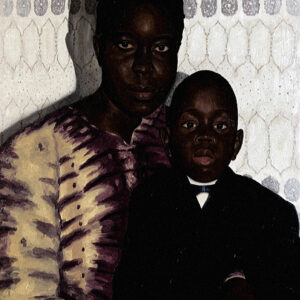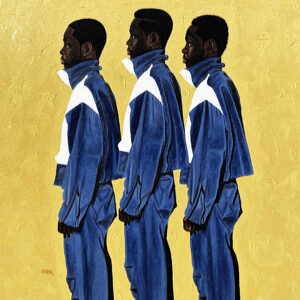
In his work, Ettebong offers a contemplative exploration of the intricate layers of identity, the trials of resistance, and the unbounded promise of renewal, elevating his art into a poignant space for dialogue, reflection, and introspection.
Maria Yigouti on the work of the Nigerian artist Ubong Ettebong
Ubong Ettebong: The Hero, The Resilient, and The Artist
Ubong Ettebong, born in 2001 in Nigeria, has quickly emerged as a promising figure in contemporary art. Raised in Uyo, he reflects on how “art served as a haven for me—a refuge where I could escape my life struggles and personal battles.” Through the act of creation, Ettebong unearthed a profound sense of liberation, transforming the canvas into a sanctuary for self-expression. This enduring bond with art has indelibly shaped his creative vision, empowering him to confront and critically engage with the socio-political narratives that reverberate within his community. In his work, Ettebong offers a contemplative exploration of the intricate layers of identity, the trials of resistance, and the unbounded promise of renewal, elevating his art into a poignant space for dialogue, reflection, and introspection.
In Ubong Ettebong’s oeuvre, heroism transcends mere valor, unfolding as a profound expression of inner resilience—an enduring force that reaches beyond the limitations of individual suffering. The figures Ettebong depicts, standing tall with proud postures and unwavering gazes, invite us to contemplate not only their intrinsic strength but also the immense adversities they have navigated. While their bodies are upright and their eyes focused with determined resolve, it is the meticulously rendered texture of their skin—achieved through the artist’s distinctive palette knife technique—that offers a deeper revelation of their lived experiences. These textured imprints, akin to scars etched into the canvas, reveal the concealed layers of identity and the unpredictable ebb and flow of existence. “My use of the palette knife to create scribbles on the skin of my figures symbolizes the moments in our lives that we often try to hide from others—and even from ourselves. While we may believe we are in control, life frequently presents us with unexpected twists, highlighting the inherent unpredictability of our journeys.” These imprints bear witness to life’s capriciousness, reminding us that even as we strive to master our narratives, we remain vulnerable to the forces that shape our journey. Through this technique, Ettebong elevates the essence of human experience, capturing the delicate tension between the visible and the hidden, the resilient and the fragile, asserting that our struggles, carved in texture and form, are the defining moments of our existence—shaping our identities, fortifying our resilience, and ultimately guiding us toward a deeper understanding of who we are and the power we hold within ourselves.
Portrait of Damson
Ubong Ettebong’s portrayal of contemporary figures pays a heartfelt tribute to those who navigate the complexities and adversities of modern life. One such striking work is Portrait of Damson, a tribute to the tenacity of Damson Idris, a British actor of Nigerian descent. “Portrait of Damson Idris celebrates the tenacity of Damson Idris, raised by his single mother after his parents immigrated to the UK in search of a better life, facing challenges in a foreign land. His roles in films like Snowfall reflect the harsh realities of growing up as a young Black boy amidst struggles and economic downturns.” Through this piece, Ettebong highlights the unyielding strength within Black identity, celebrating the courage to overcome adversity and reclaim one’s narrative with pride and determination.
This portrait encapsulates the essence of Idris’ journey—a powerful narrative of perseverance, triumph over hardship, and an unwavering will to succeed despite overwhelming odds. Much like its subject, the artwork amplifies the transformative power of personal history, illustrating how it fuels creative expression and intertwines individual and collective resilience into an evocative portrayal of contemporary perseverance. The piece transcends mere representation, embodying the stark realities of systemic inequality and the arduous paths faced by those who strive for success in a world rife with challenges. The ascents of Ettebong’s subjects serve as powerful exemplars of the relentless determination required to navigate life’s struggles while underscoring the enduring persistence that emerges in the face of adversity. Through these poignant depictions, the artist not only highlights the struggles of his subjects but also elevates their unwavering spirit—inviting viewers to step into Field of Dreams, a work that Ettebong describes as inspiring viewers “not to dwell on failed hopes and dreams but to derive strength from forging ahead.” When asked which of his paintings he would step into, Ettebong chose this piece, sharing that it embodies the importance of perseverance and the boundless potential for renewal and new beginnings. “Stepping into this painting, I hope to discover a renewed sense of purpose and resilience within myself, reflecting on the importance of perseverance in the face of adversity,” he explains. This call to action resonates across personal and collective experiences, urging viewers to find strength in life’s challenges and embrace the transformative power of tenacity.
Field of Dreams
Guided by the mentorship of Damilola Moses Opedun, a cornerstone figure within the neo-Black art movement, Ettebong has cultivated a narrative that acts as both a mirror and a lens—offering a space for cultural introspection and societal critique. Opedun, born in Lagos in 1983, has become a vital voice in contemporary Nigerian art. Raised by a single mother amidst significant emotional and familial challenges, he turned to art as a refuge and a means of exploring human emotion. “I had to go through serious emotional issues while growing up,” Opedun once shared, reflecting on how his early struggles shaped his artistic vision. Through artistic endeavor, he found stability and a way to express the raw complexity of human experience.
Opedun’s work is revered for its masterful juxtaposition of contemporary and historical elements, blending modern Black figures with Victorian fashion and centuries-old symbolism. His use of vibrant, carefully chosen colors aims to inspire hope and joy while reshaping narratives around identity and resilience. “The stance of the Black figures suggests pride in one’s identity, proud people, self-conscious. Ready to assert themselves against the world,” he explains. For Opedun, art serves as a tool not only for self-expression but also for societal transformation—a “fresh coat of paint” on painful histories, making them bearable and conducive to collective understanding and growth. He advocates for openness, urging audiences to liberate their minds from restrictive prejudices and limiting narratives, encouraging a shift towards a more inclusive, forward-thinking mindset that fosters true progress and personal growth.
Conundrum of Life
Ettebong draws deeply from these philosophies, finding in Opedun’s mentorship the courage to explore the depths of identity and resilience. “I studied under the tutelage of Damilola Opedun, one of the prominent Nigerian artists resonating with the neo-Black art movement in the 2020s. His guidance has profoundly shaped my artistic practice, encouraging me to explore the depths of identity and experience,” Ettebong reflects. Echoing his mentor’s approach, Ubong Ettebong reframes collective experiences, using his evocative body of work to challenge societal norms and offer a redefined understanding of heroism—one that celebrates resilience, empowerment, and the strength found in overcoming adversity.
My Little Hero
By engaging deeply with Black narratives, Ettebong encourages viewers to reflect on their complexities while celebrating the resilience required to overcome life’s adversities. His work, much like Opedun’s, is a call to action—a reminder of the power of self-determination, renewal, and transformation. Together, their contributions to the neo-Black art movement stand as a powerful testament to the enduring strength of identity, cultural pride, and the transformative power of storytelling through art, offering a vision of tenacity and empowerment that reshapes the narrative around Black experiences.
Maria Yigouti is an independent art writer, curator, and communications consultant based in Casablanca, Morocco. With a background in design and visual communication, she is the founder of The Yapper, an art platform dedicated to amplifying Southern and diasporic voices within the global art discourse. Her work focuses on the development of critical narratives and the curation of inclusive, thought-provoking discourses that foster cross-cultural dialogue and broaden the representation of underrepresented artistic perspectives
The artist is represented by the Ogirikan Art Gallery.
Maria Yigouti

